Role Based Access Control
Outline
- Limitation of DAC and MAC
- Role Based Access Control (RBAC)
- Reference Models
- RBAC0: Core Model
- RBAC1: Role Hierarchy
- RBAC2: Constraints
- RBAC3
Limitation of DAC and MAC
Motivations
- Organizations are constantly changing
- Changes in the organizational structure
- Users change job function within the organization
- Required flexible solution to meet changing needs
- Number of users and applications is increasing within most organizations
- Required scalable solution to manage accesses
Q&A
Suppose you want to add a photo to your wall. How to set permissions in DAC?
- Using capability list: For each user, add permission to view the photo
- Using access control list: List all users that are allowed to view the photo
Limitation
- Identity-based access control
- Access control on a per user basis
- Lack of flexibility
- No scalable
Role Based Access Control (RBAC)
Beyond Identity-based Access Control
- Access depends on job function, not on identity
- Example:
- Bob, bookkeeper for Computer Science Dept, has access to financial records
- He leaves
- Bob, bookkeeper for Computer Science Dept, has access to financial records
- Role of "bookkeeper" dictates() access, not identity of individual
- Example:
- Idea: associate access rights with job functions within an organization
Role Based Access Control (RBAC)
Goals:
- Describe organizational access control policies
- Based on job function:
- A user's permissions are determined by her roles
- rather than by identity or clearance
- Increase flexibility/scalability in policy administration
- Easy to meet new security requirements
- Reduce errors in administration
- Reduce cost of administration
RBAC:Intuition
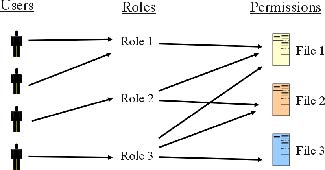
RBAC
- Roles defined based on job function, e.g.,bookkeeper
- Permissions defined based on job authority and responsibilities within a role,e.g.,bookkeeper is allowed to read financial records
- Users have access to objects based on the assigned role, e.g., Sally is the bookkeeper
RBAC Security Principles
- Least privilege: No more privileges than necessary to perform assigned job
- Separation of duties: Pervent users from abusing their position
Least Privilege
Problem: users can have ability to perform potentially harmful actions as a side effect of granting ability to perform desired functions
Least Privilege: User is given no more permission than it is necessary to perform her job function
- Roles engineered based on teh principle of least privilege
- Identify user's job functions
- Determine minimum set of privileges required to perform them
- Users assigned to roles based on their job function
- Users assigned to the same roles have same permissions
Separation of duties
Problem: users can abuse their position within an organization
Separation of duties: Require more than one user to perform critical tasks
- e.g., two distinct clerks are needed to issue a check
Where RBAC is used
RBAC is currently used in
- Database management systems
- Enterprise Application for Security Administration and User Management
Applicatons(using some form of RBAC)
- Microsoft Active Directory
- Microsoft SQL Server
- IBM Tivoli
- FreeBSD
- Solaris
- Oracle DBMS
- PostgreSQL 8.1
RBAC:Summary
Simplify definition and administration of access control policies
- Policies based on duty and responsibility of job functions
- Assignment of permissions to users
- Permissions associated with roles
- Users assigned to appropriate roles
- Updates for roles instead of updating privileges for every user
- User changes job function?
- Add/Remove permission for a job function?
Four Reference Models
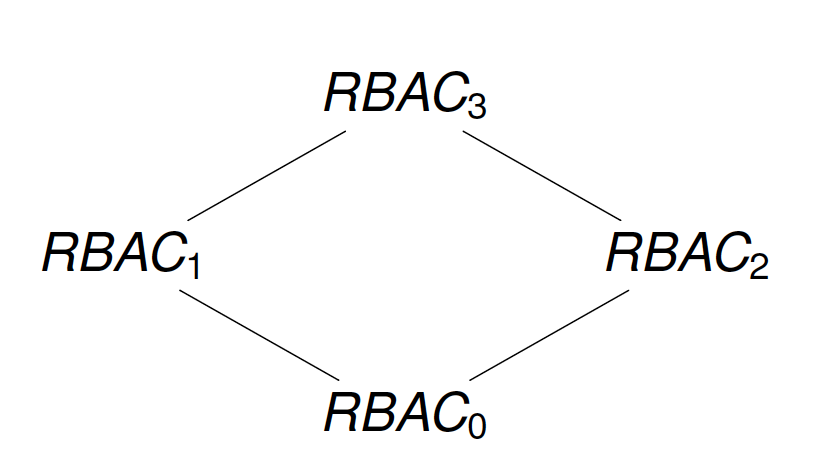
- RBAC0: Core Model
- RBAC1: Role Hierarchy
- RBAC2: Constraints
- RBAC3
RBAC0 concepts
- User
- a human being or intelligent autonomous agent
- Role
- job function within the context of organization
- associated semantics regarding its authority and responsibility
- Permission
- an operation that can be exercised on objects
- objects and operations are domain dependent
- Session
- instance of a connection of a user to the system
- mapping of users to roles/permissions at a given time
- define set of activated roles
RBAC0 Model
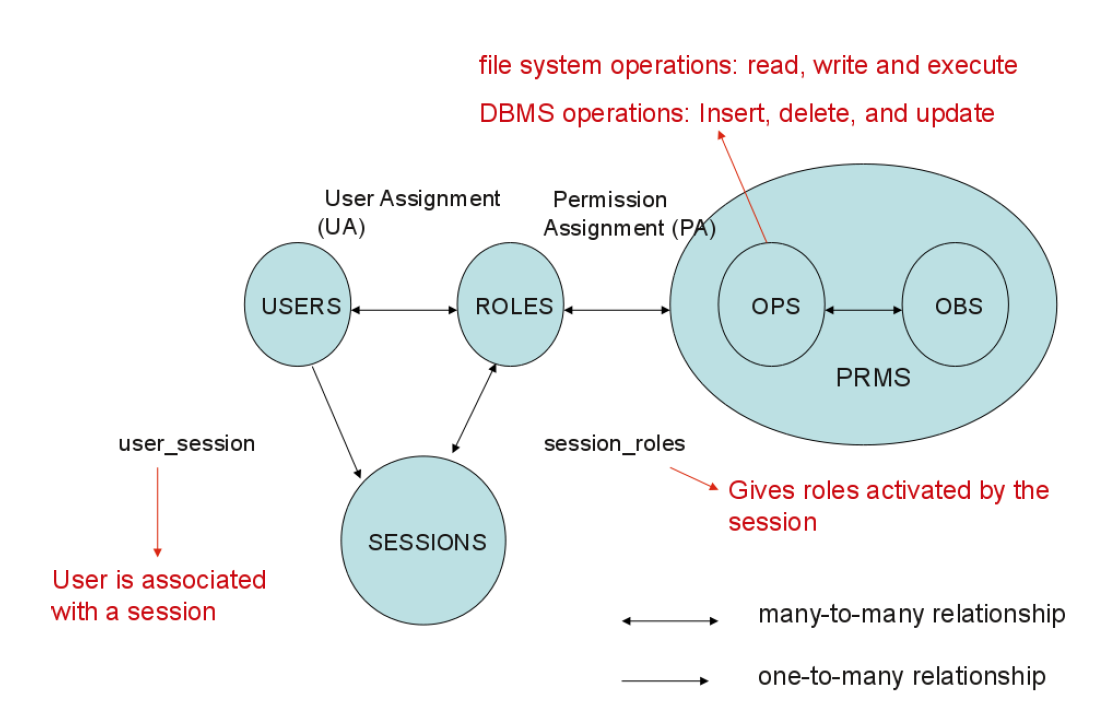
- U Users
- R Roles
- OPS Operations
- OBS Objects
- P ⊆ OPS × OBS Permissions
- SE Session
- UA ⊆ U × R User Assignment
- PA ⊆ P × R Permission Assignment
- A subject can have multiple roles
- A role can have multiple subjects
- A role can have many permissions
- A permission can be assigned to many roles
Exercise
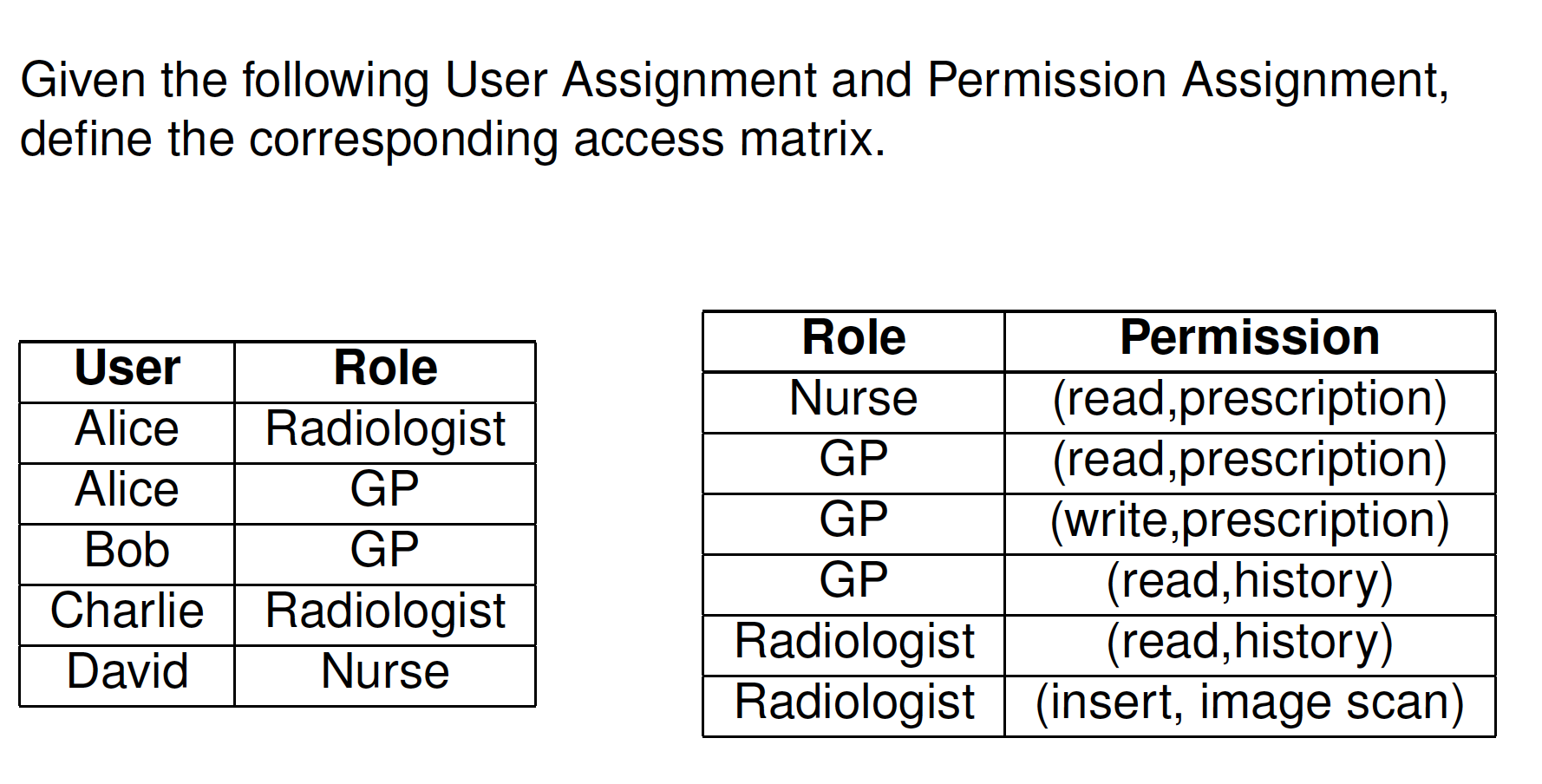
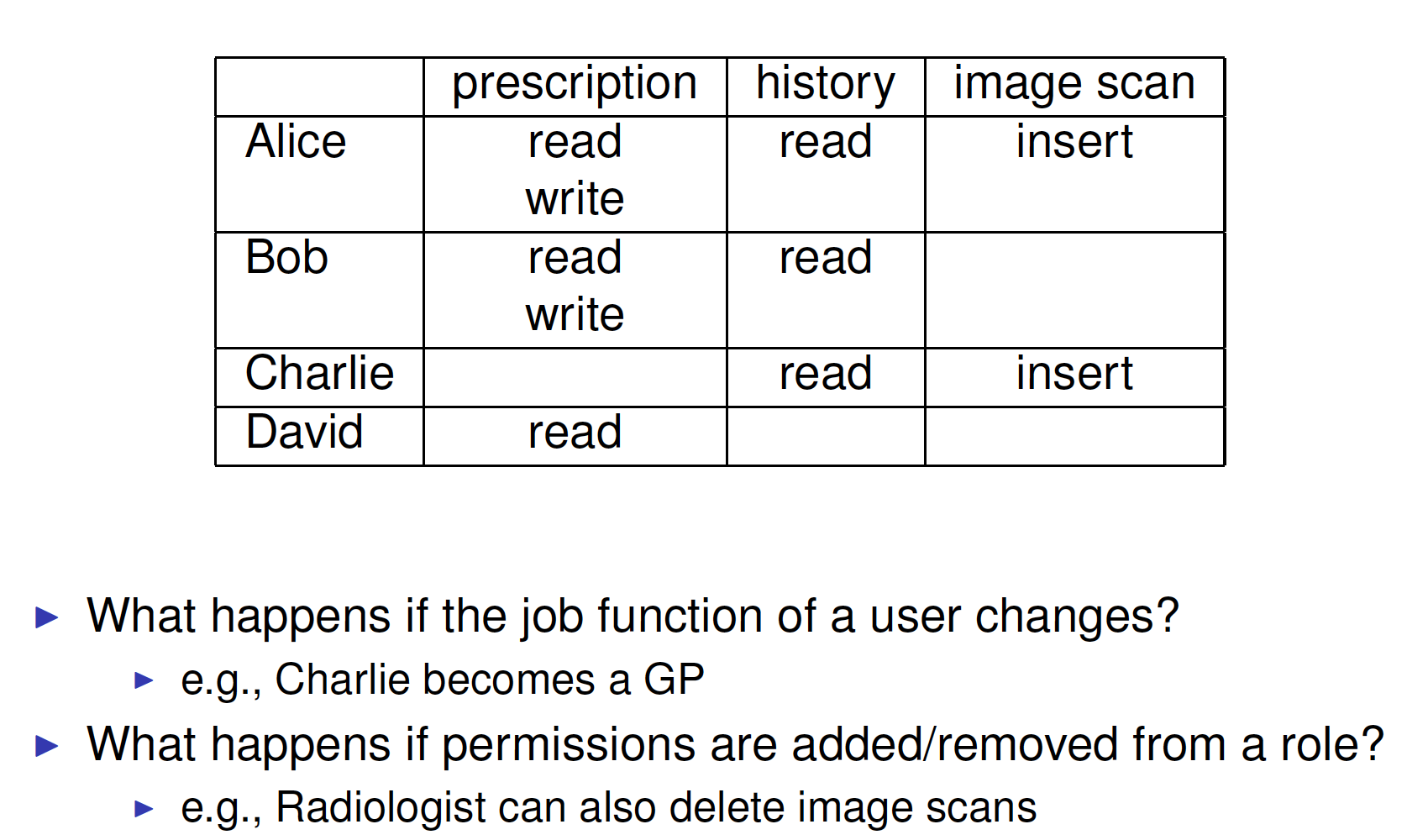
RBAC1: Role Hierarchy
- Some roles subsume(把……归入;把……包括在内) others见36
- This suggests a hierarchy of roles
- Reflect an organizaiton's role structure
- Inheritance among roles
- Instead of specifying permissions for each role, one specifies it for a more generalized role
- Granting access to role R implies that access is granted for all specialized roles of R
Role Hierarchy
- Structuring roles
- Partial order ≤:x ≤ y we say x is specialization of y
- Inheritance of permission from generalized role y(top) to specialized role x(bottom)
- Members of x are also implicitly members of y
- if x ≤ y then role x inherits permissions of role y
- Partial order
- Reflexivity(i.e., x ≤ x)自反性
- Transitivity(i.e., x ≤ y and y ≤ z then x ≤ z)传递性
- Antisymmetry(i.e., x ≤ y and y ≤ x then x= y)反对称性
Role Hierarchy-Examples
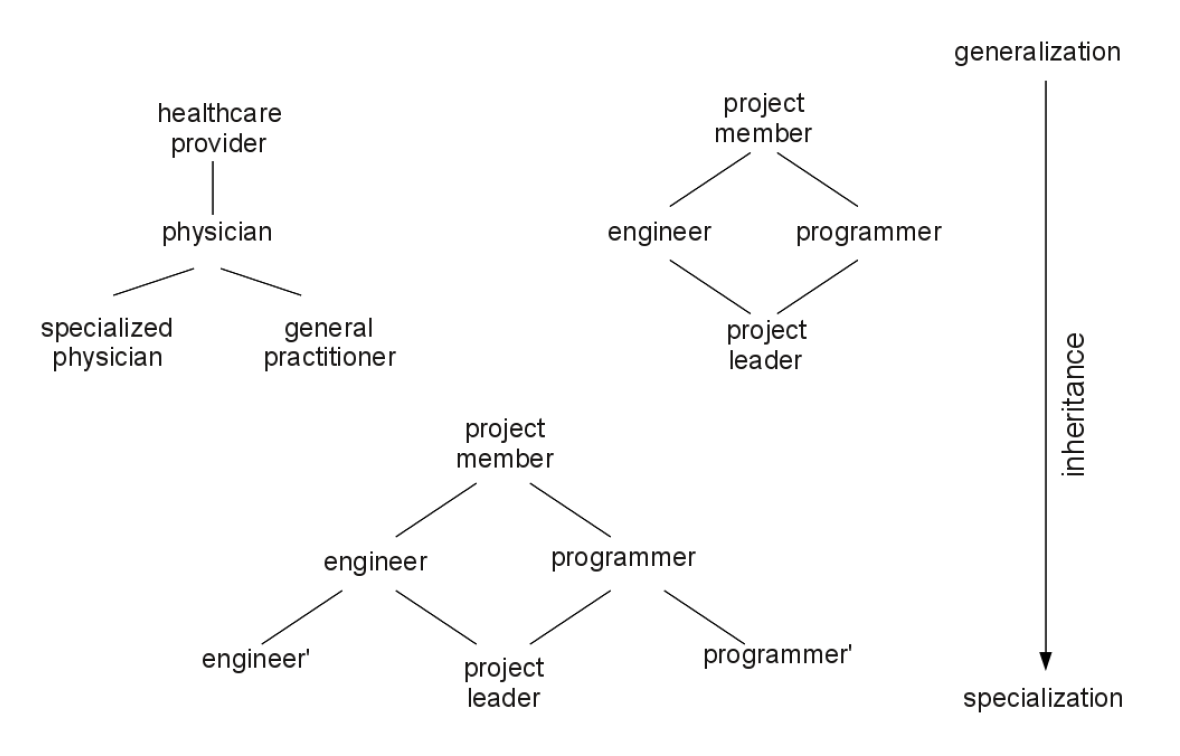
RBAC1 Model
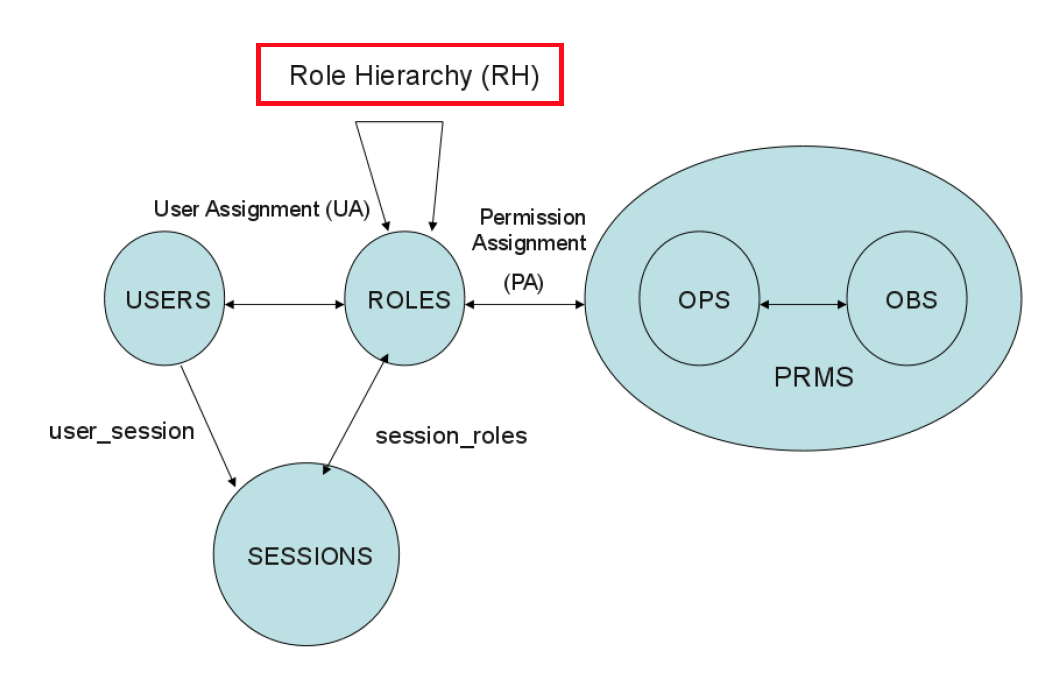
Exercise 见40-43
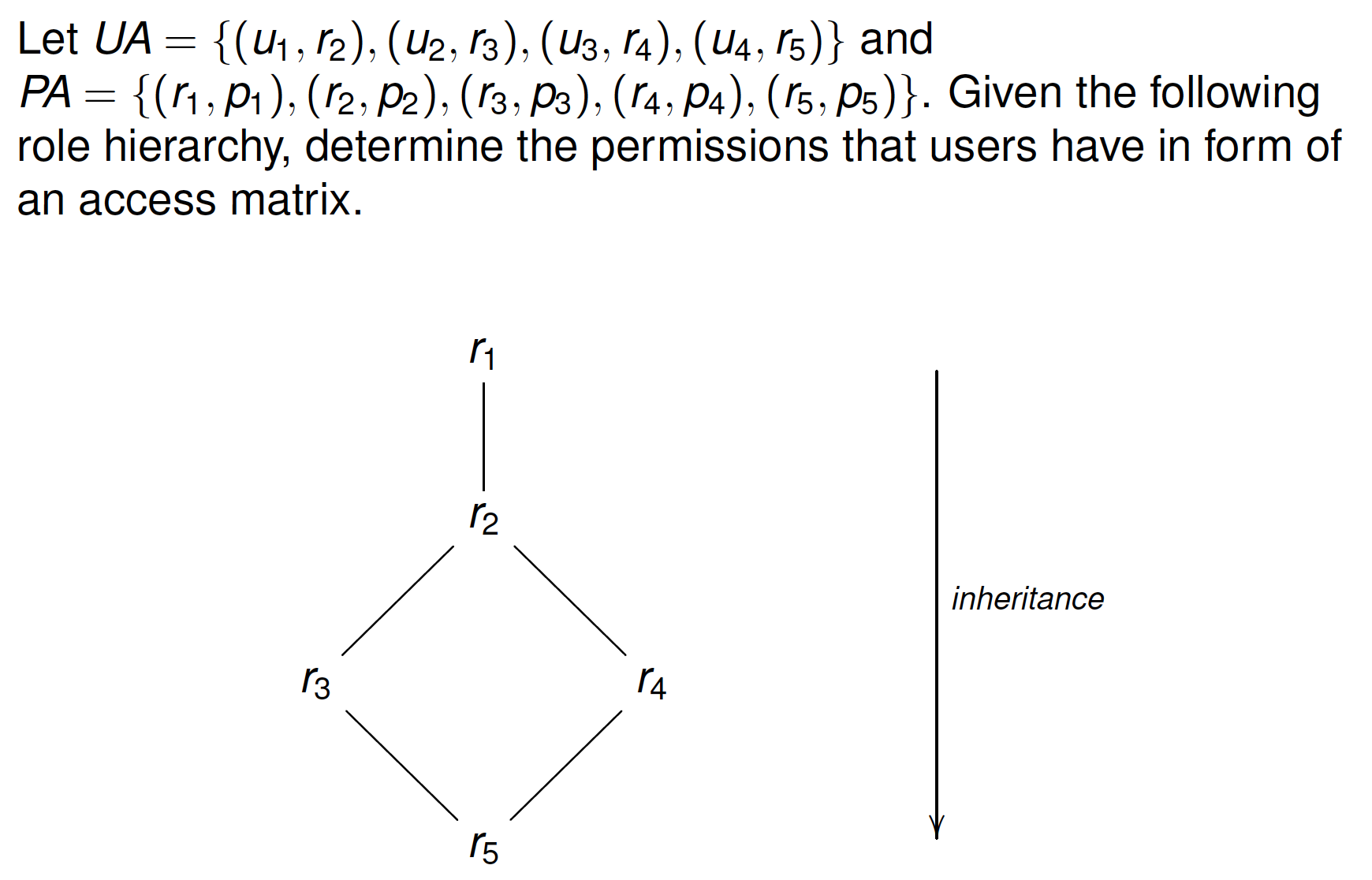
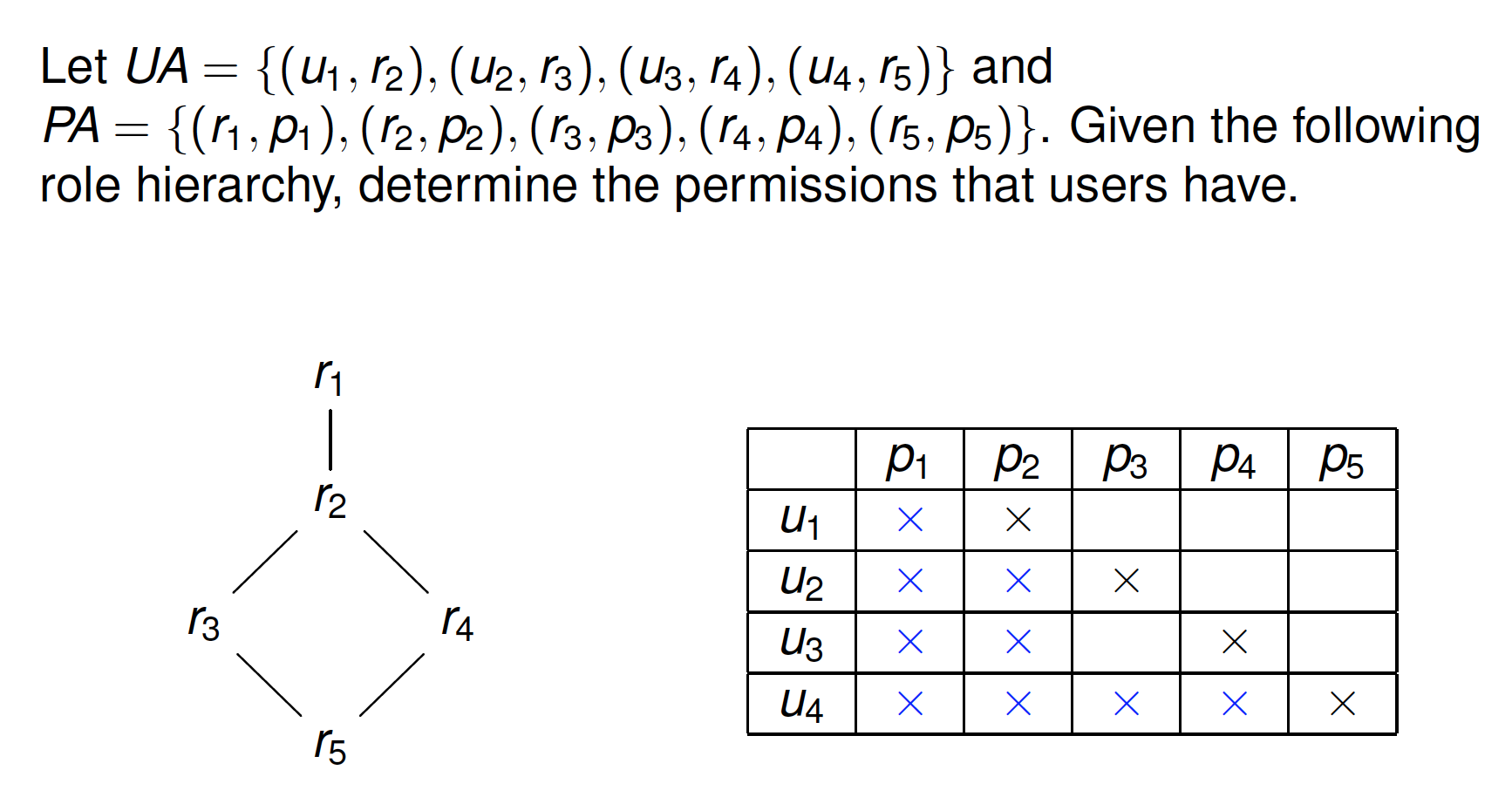
Remark
- Sometimes, used reversed role hierarchical
- Dominance(优势;支配地位;控制力) relation instead of specialization
- Inheritance from bottom to top
- What is the problem of inheritance with respect to dominance?
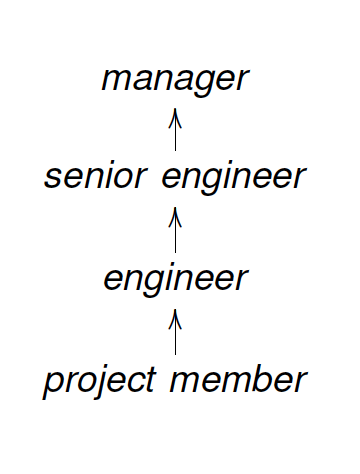
RBAC2
- Mutually Exclusive Roles
- Enforce separation of duty
- Cardinality(集的势) constraints
- Number of users that can be assigned to a role simultaneously
- Number of roles that a user can have
- Prrequisite roles
- User can be assigned to role A only if the user is already a member of role B
Conflicts of Interest
- User gains advantages because
- Access information about competitors(Chinese Wall)
- Abuse his position within the organization(RBAC)
- Ensure that two or more users are involved in executing critical operations
- Restrict combinations of privileges made available to users
Q&A见47-49
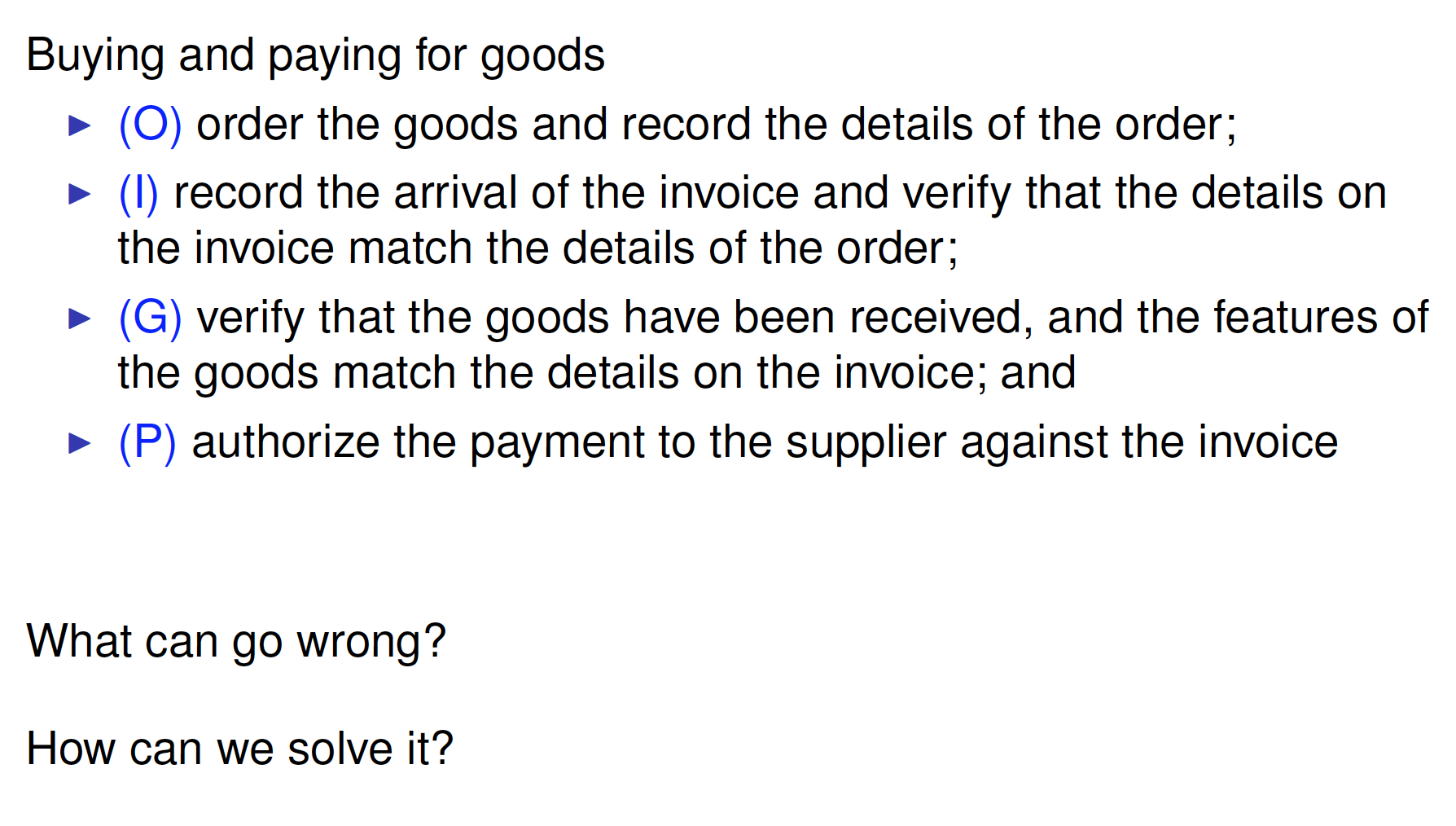
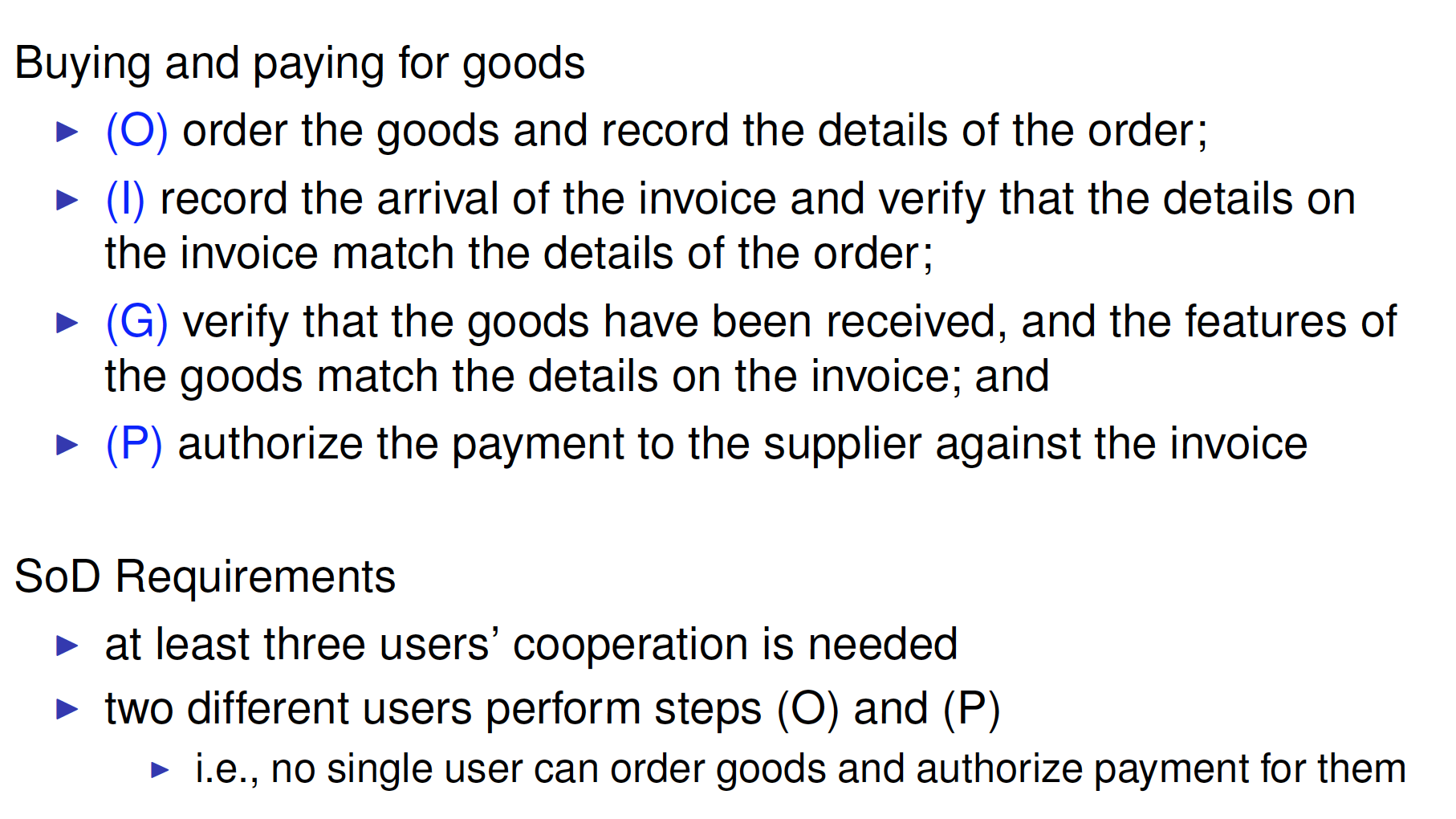
Separation of Duty
Principle: collaboration of multiple users needed to perform sensitive tasks
- Static Separation of Duty (SSoD): Restrict the permissions that can be assigned to a user
- Dynamic Separation of Duty (DSoD): Restrict the permissions that can be exercised by a user
Static Separation of Duty (SSoD)
Multiple users together should have the permissions to perform sensitive tasks Static Separation of Duty constraint ssod(ps,n)
- at least n user are needed to cover all permissions in permission set ps
In our example.. 见52
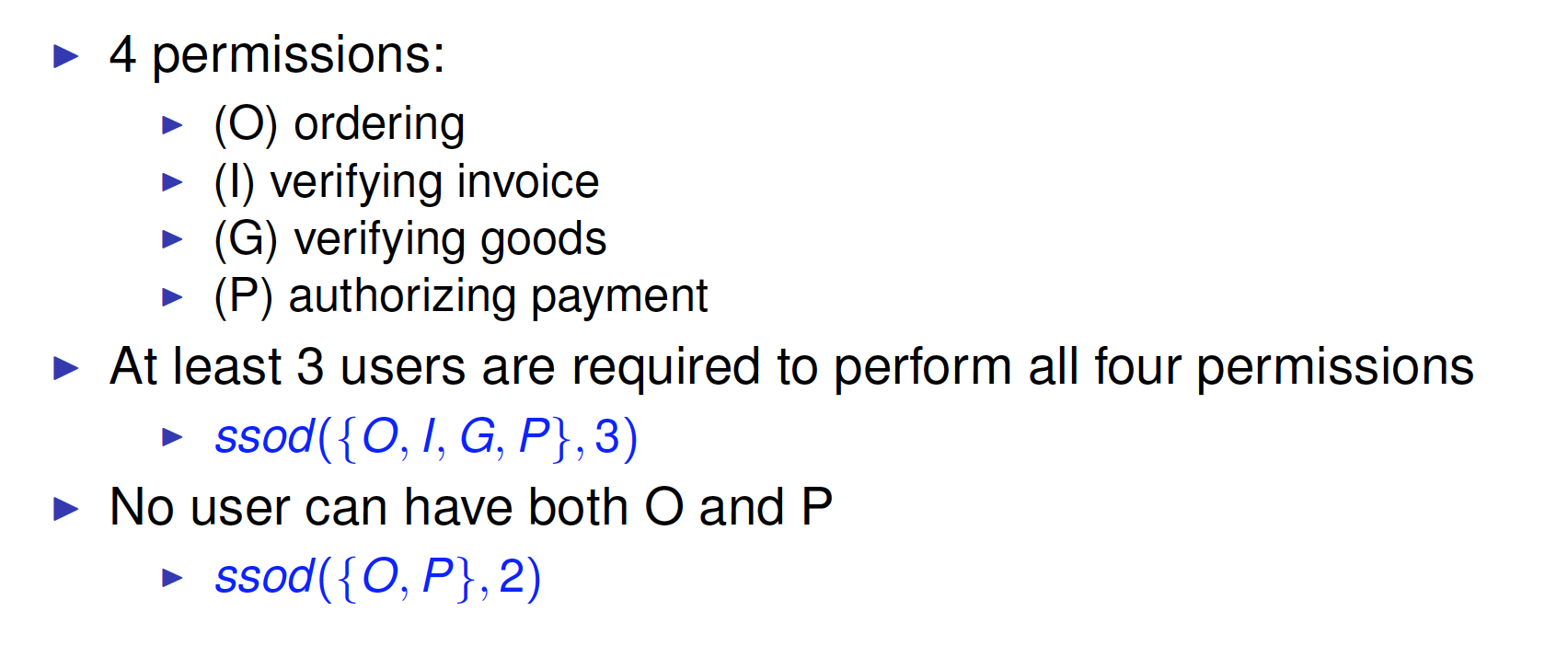
Exercise 见54,55
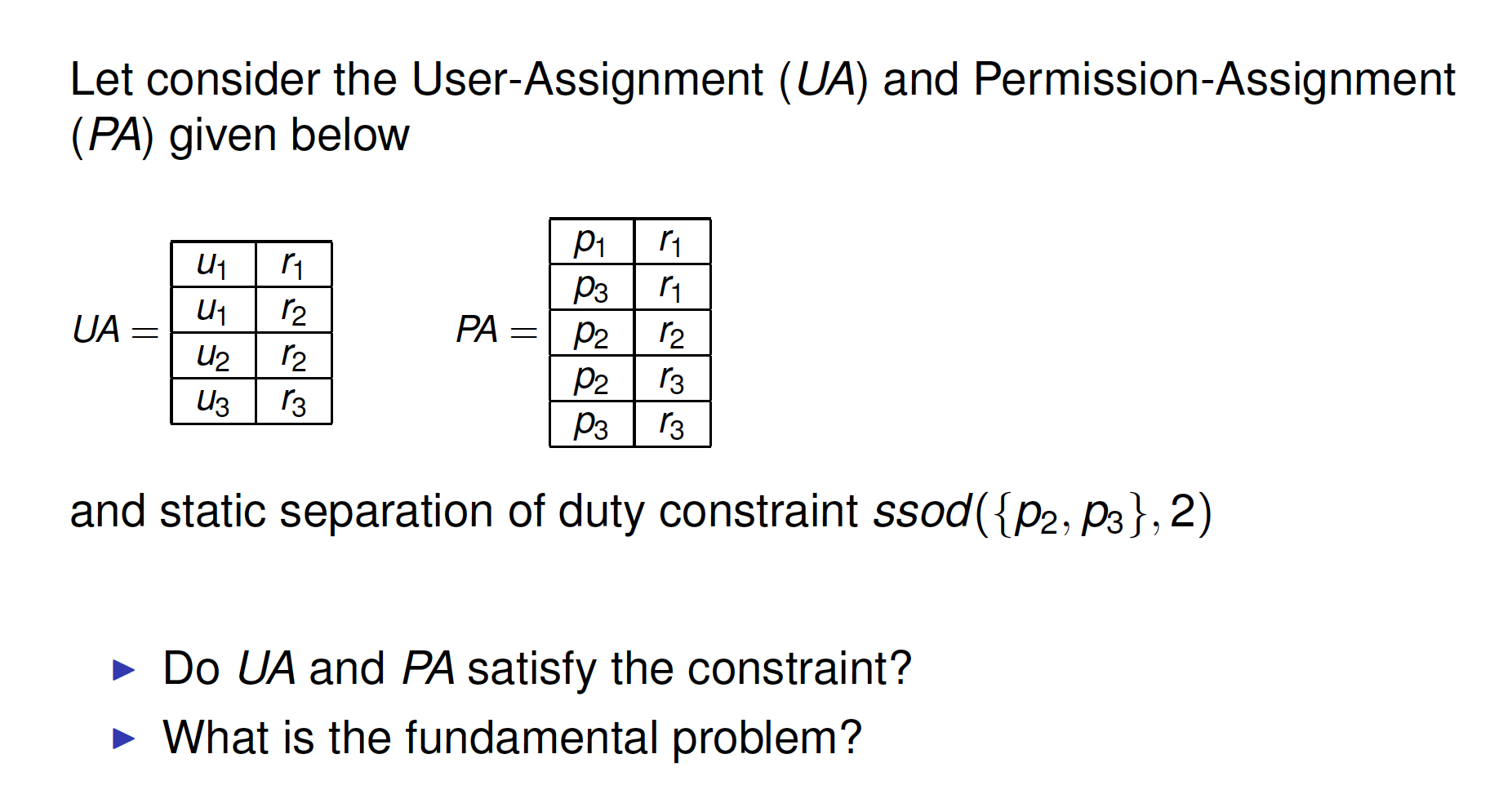
- inconstraint r3 both p2 and p3
Static Separation of Duty (SSoD)
- SSoD used to place constrains on permissions assigned to users
- In our example:见56
- SSoD can be too restrictive
- In our example: 见56
Dynamic Separation of Duty (DSoD)
Dynamic Separation of Duty
- Object-based Separation of Duty: no user may act upon an object that that user has previously acted upon
- History-based Separatio of Duty: no user is allowed to perform all the actions in a business task on a (collection of) objects
Mutually Exclusive Roles
Enforcement of separation of duty in RBAC
- Static Mutually Exclusive Roles
- Static separation of duty
- Restrictions on the roles that can be assigned to a user
- Dynamic Mutually Exclusive Roles
- Dynamic separation of duty
- Restriction on the roles that a user can activate in a session
Static Mutually Exclusive Roles
Static Mutually Exclusive Roles constraint smer(rs,n)
- Any user cannot be assigned to n or more roles in role set rs
RBAC2 Model with SMER
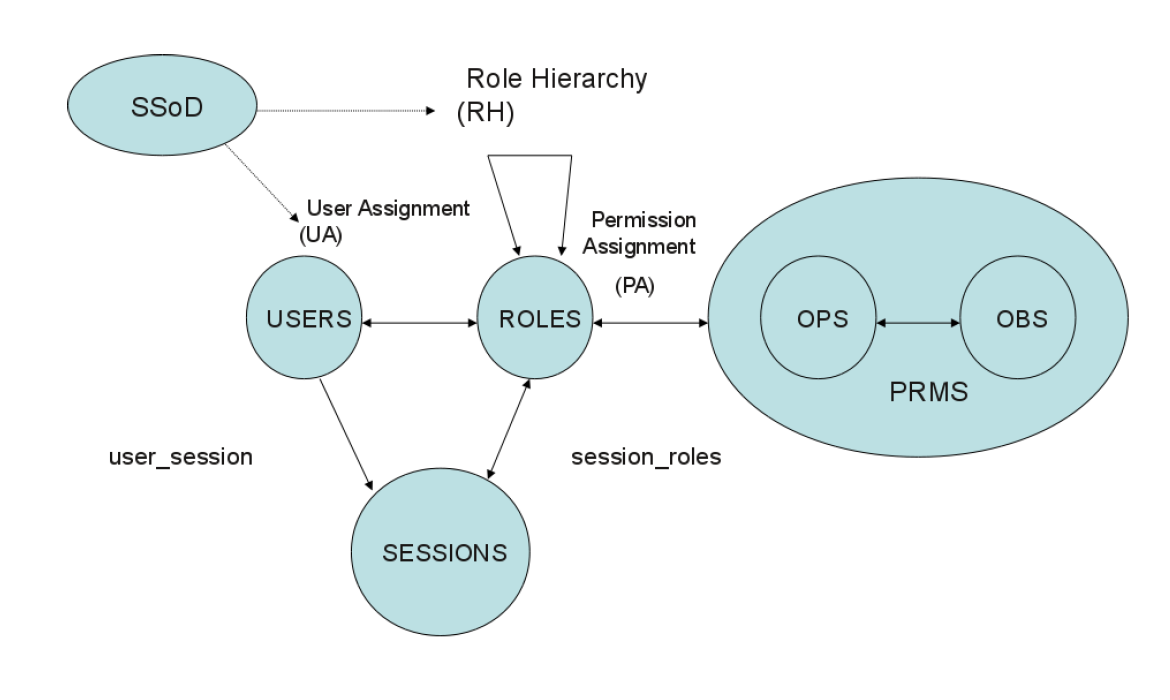
Exercise 见61-62
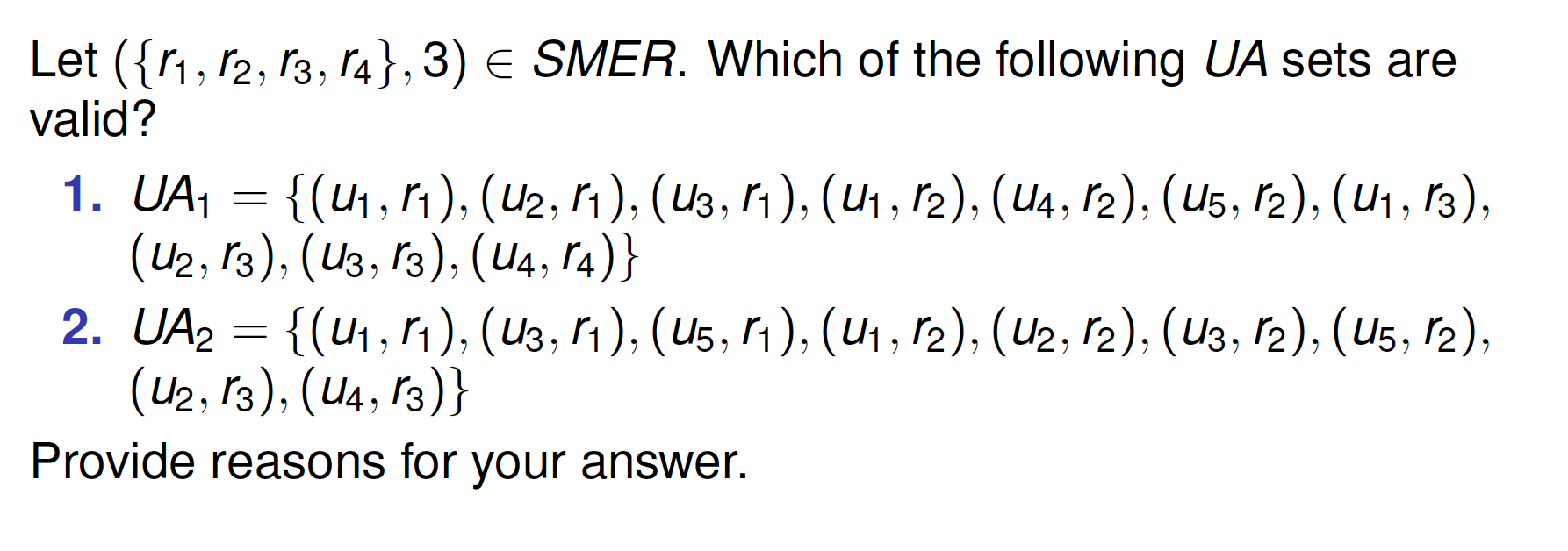
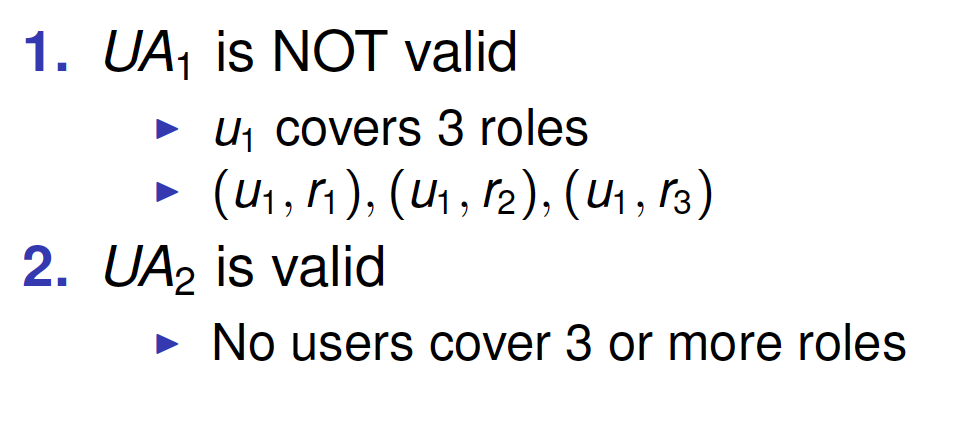
Dynamic Mutually Exclusive Roles(DMER)
- User can activate multiple roles in one session
- DMER used to restrict role activation
- Dynamic Mutually Exclusive Roles constraint dmer(rs,n)
- user cannot simultaneously activate n or more roles from role set rs in one session
RBAC2 Model with DMER
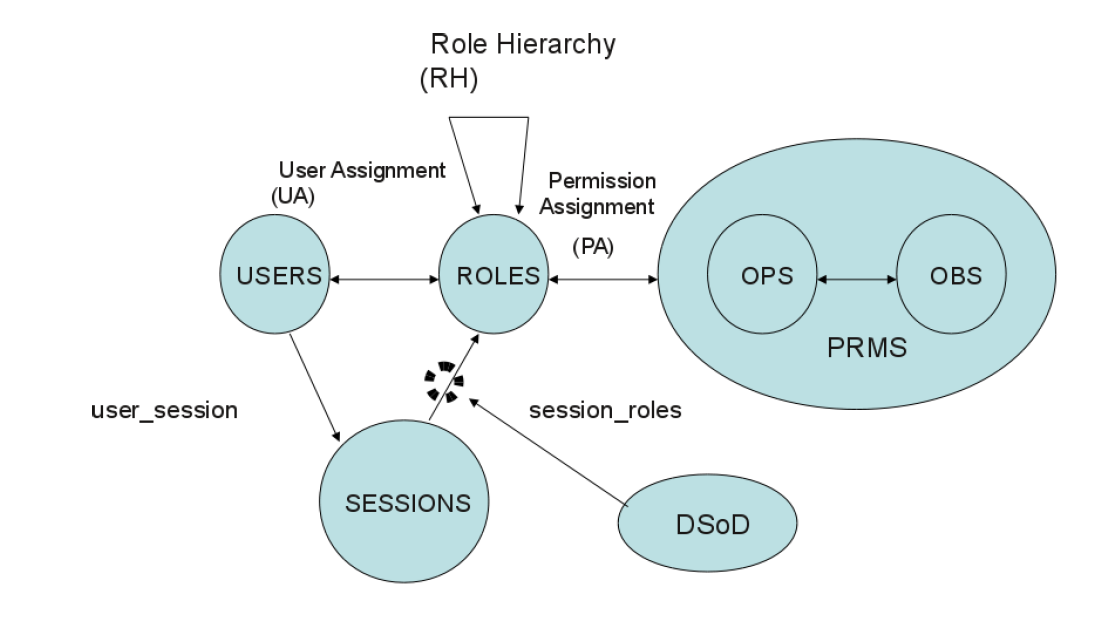 DMER place constraints on the roles that can be activated in a user’s session. If one role that takes part in a DMER is activated, the user cannot activate the related (conflicting) role in the same session
DMER place constraints on the roles that can be activated in a user’s session. If one role that takes part in a DMER is activated, the user cannot activate the related (conflicting) role in the same session
Other Constraints
- Cardinality constraints on User-Role Assignment
- At most k users can belong to the role
- At least K users must belong to the role
- Exactly k users must belong to the role
- Prerequisite roles
- Dictate that a user can only be assigned to a particualr role if it is already assigned to some other specified role
RBAC3
- Consolidated model
- Combine RBAC1 and RBAC2
- Support
- RBAC0
- Constraints
- Role Hierarchies
Summary
- Limitation of DAC and MAC
- Lack of flexibility
- No scalable
- Role Based Access Control (RBAC)
- Reference Models
- RBAC0: Core Model
- RBAC1: RBAC0 + Role Hierarchy
- RBAC2: RBAC0 + Constraints
- RBAC3: RBAC1 + RBAC2